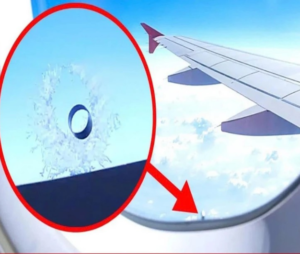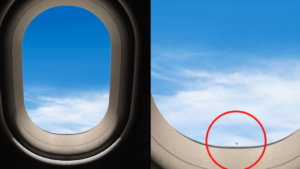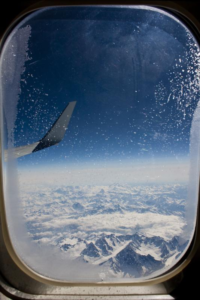If you’ve ever sat by the window on an airplane, you’ve likely noticed a tiny hole near the bottom of the window. It’s easy to overlook this small detail as you gaze out at the clouds or the landscape below. However, this tiny feature plays a critical role in keeping you safe during your flight. Let’s take a closer look at why that little hole in airplane windows is so important, and what it does to maintain safety and comfort while flying.

The Mystery Behind the Small Hole in Airplane Windows
The small hole you see in airplane windows is called a “bleed hole.” It’s a crucial component of the window’s design, and while it might seem like just a minor detail, it performs vital functions. Many passengers who notice it might wonder, “Is that hole supposed to be there?” The answer is an emphatic yes!
But why exactly is this hole necessary? To understand its purpose, it’s essential to delve into the structure of airplane windows and the physics of flying at high altitudes.
Airplane Windows: Layers of Protection
Airplane windows aren’t just single sheets of glass or plastic. In fact, they are made of three separate panes—the outer pane, the middle pane, and the inner pane. Each of these panes serves a specific function that ensures the safety and comfort of passengers:
Outer Pane: This is the strongest pane, designed to withstand the full force of the air pressure difference between the inside of the cabin and the outside atmosphere.
Middle Pane: This pane acts as a backup in case the outer pane fails. The bleed hole is located here, and it plays an important role in regulating pressure.
Inner Pane: The inner pane is primarily for protection, ensuring passengers don’t accidentally damage the middle or outer panes.
Together, these panes form a highly effective barrier, keeping the cabin pressurized while ensuring passengers can enjoy clear, unobstructed views during their flight.
Balancing Air Pressure with the “Bleed Hole”
Airplane cabins are pressurized to ensure passengers can breathe comfortably as the plane ascends to high altitudes where the air is much thinner. As the airplane climbs, the air pressure outside drops significantly compared to the pressure inside the cabin. This creates a situation where there is a large pressure difference between the cabin and the outside air, which could put extreme strain on the airplane windows.
The bleed hole in the middle pane helps regulate this pressure difference. Here’s how it works:
Pressure Regulation: The bleed hole allows a small amount of cabin air to pass between the inner and outer panes. This equalizes the pressure between the cabin and the gap between the panes, ensuring that the outer pane bears the majority of the pressure. Essentially, the middle pane becomes a backup, ready to handle the pressure in case the outer pane fails.
Safety Backup: By allowing pressure to balance gradually, the bleed hole ensures that no one pane takes on the full pressure load all at once. This makes the system much safer and more reliable.
Preventing Window Fogging and Frost

Another important function of the bleed hole is moisture control. At high altitudes, temperatures outside the airplane can drop drastically, causing condensation and frost to form on surfaces. Without proper airflow, airplane windows could easily fog up, obstructing the view and making it difficult for passengers to enjoy the scenery.
The bleed hole allows a small amount of air to flow through, preventing moisture from building up between the window panes. This not only keeps the windows clear but also prevents ice from forming on the interior of the window.
What Happens If the Bleed Hole Wasn’t There?
If airplane windows didn’t have this small hole, the effects could range from inconvenience to danger:
Pressure Imbalance: Without the bleed hole, there would be no way to equalize the pressure between the cabin and the space between the window panes. Over time, this pressure difference could cause the windows to crack or fail, which would be a serious safety risk.
Foggy Windows: Passengers would have to deal with fogged-up windows, making it impossible to see out. This would be especially frustrating during long flights when enjoying the view is a great way to pass the time.
Increased Stress on the Window: The outer pane would have to bear the full pressure difference without any help from the other panes, increasing the likelihood of damage over time.
In short, the bleed hole is essential for both safety and passenger comfort.

The Science of Air Pressure and Altitude
To fully appreciate why the bleed hole is so important, it’s helpful to understand how air pressure changes as an airplane climbs to cruising altitude. At sea level, the air pressure is much higher than it is at 30,000 feet. As a plane ascends, the air pressure outside the aircraft drops dramatically.
Without proper cabin pressurization, passengers would experience difficulty breathing and other altitude-related issues. Inside the cabin, air is pressurized to mimic the conditions at around 6,000 to 8,000 feet above sea level. However, the pressure outside remains much lower, creating a pressure differential that needs to be managed to ensure the safety of the aircraft.
How Airplane Engineers Solved the Pressure Problem
The engineers who designed modern airplane windows knew they needed a solution to prevent windows from cracking under the pressure. By creating a multi-pane system and introducing the bleed hole, they were able to solve the challenge of managing pressure differences while maintaining clear visibility for passengers.

The result is a simple yet brilliant design that keeps us safe in the sky, all thanks to that small, often unnoticed hole.
Why You Should Appreciate That Tiny Hole on Your Next Flight
The next time you board a flight and settle into your window seat, take a moment to appreciate the engineering marvel that is the airplane window. The tiny bleed hole, though small, plays an outsized role in ensuring a safe and comfortable flight.
From regulating air pressure to preventing fogging, that little hole allows you to enjoy a clear view of the clouds while keeping you safe from the pressure differentials that come with high-altitude flying. So, the next time you fly, you’ll know the secret behind one of the smallest yet most essential parts of the airplane’s design.
In conclusion, this seemingly insignificant hole is far more important than it appears. It’s a reminder that even the tiniest details can have a big impact on our everyday experiences—especially when it comes to air travel. Safe travels!





